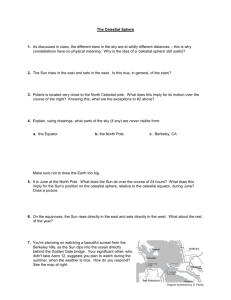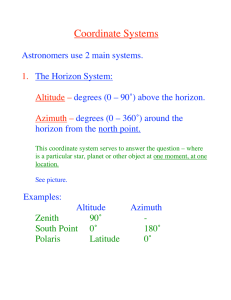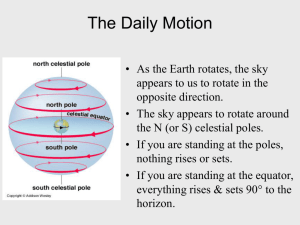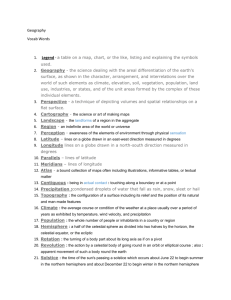INSIDE LAB 2: Celestial Motions
advertisement
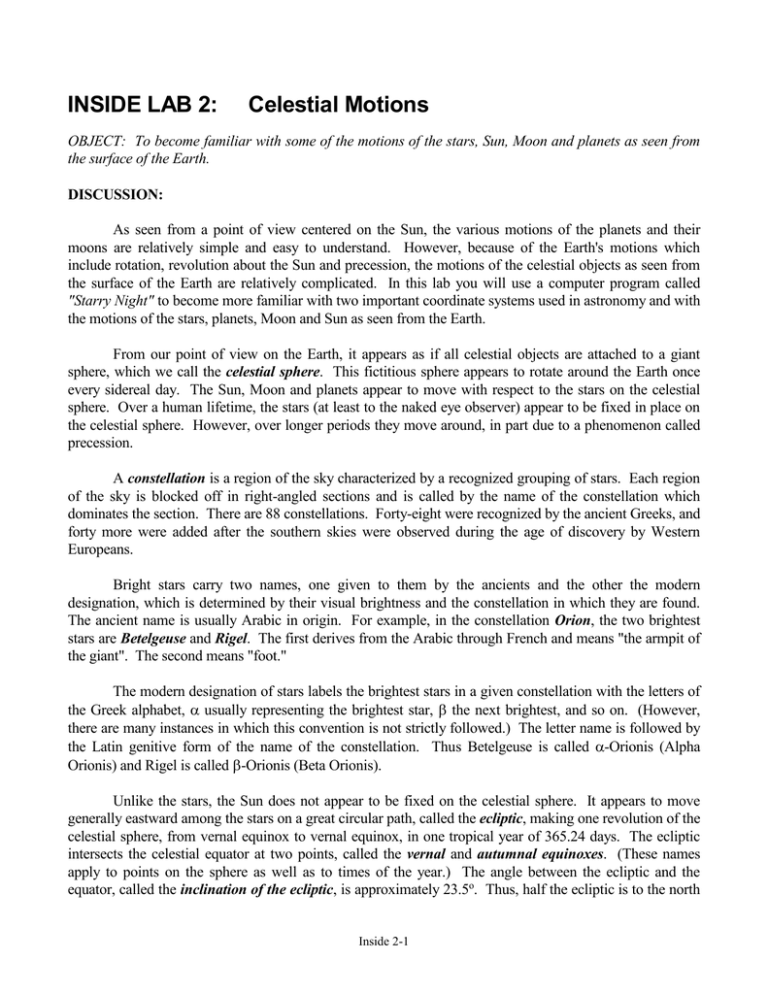
INSIDE LAB 2: Celestial Motions OBJECT: To become familiar with some of the motions of the stars, Sun, Moon and planets as seen from the surface of the Earth. DISCUSSION: As seen from a point of view centered on the Sun, the various motions of the planets and their moons are relatively simple and easy to understand. However, because of the Earth's motions which include rotation, revolution about the Sun and precession, the motions of the celestial objects as seen from the surface of the Earth are relatively complicated. In this lab you will use a computer program called "Starry Night" to become more familiar with two important coordinate systems used in astronomy and with the motions of the stars, planets, Moon and Sun as seen from the Earth. From our point of view on the Earth, it appears as if all celestial objects are attached to a giant sphere, which we call the celestial sphere. This fictitious sphere appears to rotate around the Earth once every sidereal day. The Sun, Moon and planets appear to move with respect to the stars on the celestial sphere. Over a human lifetime, the stars (at least to the naked eye observer) appear to be fixed in place on the celestial sphere. However, over longer periods they move around, in part due to a phenomenon called precession. A constellation is a region of the sky characterized by a recognized grouping of stars. Each region of the sky is blocked off in right-angled sections and is called by the name of the constellation which dominates the section. There are 88 constellations. Forty-eight were recognized by the ancient Greeks, and forty more were added after the southern skies were observed during the age of discovery by Western Europeans. Bright stars carry two names, one given to them by the ancients and the other the modern designation, which is determined by their visual brightness and the constellation in which they are found. The ancient name is usually Arabic in origin. For example, in the constellation Orion, the two brightest stars are Betelgeuse and Rigel. The first derives from the Arabic through French and means "the armpit of the giant". The second means "foot." The modern designation of stars labels the brightest stars in a given constellation with the letters of the Greek alphabet, usually representing the brightest star, the next brightest, and so on. (However, there are many instances in which this convention is not strictly followed.) The letter name is followed by the Latin genitive form of the name of the constellation. Thus Betelgeuse is called -Orionis (Alpha Orionis) and Rigel is called -Orionis (Beta Orionis). Unlike the stars, the Sun does not appear to be fixed on the celestial sphere. It appears to move generally eastward among the stars on a great circular path, called the ecliptic, making one revolution of the celestial sphere, from vernal equinox to vernal equinox, in one tropical year of 365.24 days. The ecliptic intersects the celestial equator at two points, called the vernal and autumnal equinoxes. (These names apply to points on the sphere as well as to times of the year.) The angle between the ecliptic and the equator, called the inclination of the ecliptic, is approximately 23.5o. Thus, half the ecliptic is to the north Inside 2-1 of the celestial equator, and half is to the south. The northernmost point of the ecliptic, called the summer solstice, is the position of the Sun on the first day of summer (in the northern hemisphere of the earth). The southernmost point, the winter solstice, is the position of the Sun on the first day of winter. The Sun arrives at the vernal equinox around March 22, the summer solstice around June 22, the autumnal equinox around September 22, and the winter solstice around December 22. There are several coordinate systems in use in astronomy by which we locate the positions of heavenly bodies. The two most important ones for our purposes are the horizon system and the equatorial system. The horizon system, locates these bodies relative to the celestial horizon and the direction of north. The equatorial system, locates them relative to the celestial equator and the vernal equinox. Zenith Altitude North Azimuth Horizon The horizon system measures the position a celestial object is at in the sky at a given time. This is done by using the coordinates altitude and azimuth. If an object is straight overhead its altitude is 90° and it is said to be at the zenith. Altitudes are measured by drawing a great circle (a circle centered at the center of the Earth) which intersects both the object and the zenith. The altitude is the angular distance along the circle from the horizon to the object. The azimuth is the angle measured along the horizon clockwise from due North to the point at which the great circle intersects the horizon. Thus altitude goes from 0° on the horizon to 90° at the zenith while azimuth goes from 0° at North to 360° which is again North. The direction East is 90°, South is 180°, etc. Because of the Earth's rotation, the position of celestial objects in the sky is constantly changing. Thus it is useful to have a coordinate system which allows us to determine the location of the stars and planets with respect to each other. One very useful system is the equatorial system which is used by observatories around the world. It is based on a system identical to the latitude and longitude coordinate system that is used on the Earth. However this system is used on the celestial sphere. The system is as follows: Just as the earth is girded by an equator, so also do we define a celestial equator girding the celestial sphere. This great circle lies on the celestial sphere directly over the equator of the earth. There is a point on the celestial equator, called the vernal equinox, at which the Sun is found Inside 2-2 on the first day of spring. The vernal equinox is the origin of coordinates in the equatorial system. The celestial equator has poles, just as does the equator of the earth. The north celestial pole is the point on the sphere which lies directly over the north pole of the earth, and the south celestial pole is the point on the sphere which lies directly over the south pole of the earth. In order to locate a point on the celestial sphere, we first imagine drawing a great circle from pole to pole through the point. Such a circle is called an hour circle. This hour circle intersects the celestial equator at a point called the foot of the hour circle. We measure the angular distance eastward from the vernal equinox along the celestial equator to the foot of the hour circle through the point. This eastward angular position is called the right ascension of the point. Next we measure the angular separation of the point from the celestial equator along the hour circle through the point. This angle is called the declination of the point. It is the angular distance of the point north or south of the celestial equator. North Celestial Pole Declination is measured in degrees, and is positive if the star is to the north of the celestial equator, and negative if to the south. Right ascension, however, is measured in hours, minutes, and seconds, where 24 hours is equivalent to 360o. That is, 1 hr equals 15o. For example, a star whose right ascension is 4 hr is at an angle of 60o to the east of the vernal equinox. Hour Circle Celestial Equator Star Declination For this lab you will use the computer program “Starry Night.” Notice the bar running across the top of the window. Vernal Right Toward the left is a section for the Time and Date. To the Foot Equinox Ascension right of this is a section where you can set the Time Flow Rate. Next is your Viewing Location, followed by the Gaze and the Zoom. These last two indicate which way you are South Celestial Pole looking and how much of the sky you see. If you click anywhere on the “sky”, you will see information appear in the upper right hand of the window giving the altitude and azimuth for the point on the sky you selected. These coordinates correspond to the position of the “mouse”. By moving the mouse so it is on top of a celestial object and pressing the left mouse button, you can find the location of that object in the. Check to see that the date and time are correct. You can change the direction you are looking in either by using the arrow keys, by “grabbing” the sky and moving it with the mouse, or by typing n, s, e, w, or z for North, South, East, West, or Zenith. You can zoom in by typing +. You can zoom out by typing -. Inside 2-3 EXERCISES 1. You can use “Starry Night” to see the daily motions of celestial objects. First arrange to look west. Then hit the zoom keys (+/-) until you can see just SW, W, and NW on the horizon. Now go to the “Time Flow Rate” section and set the time step to 30 seconds. Using the VCR controls underneath the “Time Flow Rate” section, you can now watch the sky change rapidly in increments of 1 minute. What happens to the stars near the horizon? Sketch the horizon line and draw an arrow in the direction of motion. Answer: Sketch: Next look towards the East and repeat the exercise. What do you see? (You may need to reset the time by clicking on the “Now” button located underneath the “Time and Date” section. Sketch the horizon again, and the direction of motion for the celestial objects. Answer: Sketch: Inside 2-4 Finally look towards the North and sketch the motion. Describe how the stars are moving. Do you see anything different? Do all stars rise and set as seen from Winston-Salem? If not, which constellations entirely consist of stars that never set? Which have some stars that rise and set and some that don't? [You may want to stop the Sun from brightening the sky. You can do this by clicking on the “View” menu and selecting “Hide Daylight.”] Answer: Sketch: 2. To see the sky from other locations click on the “Viewing Locations” section and select “Other…” from the menu that pops up. Next, choose either your home town or the large city nearest your home town. If your home town is in North Carolina, South Carolina, or Virginia, choose some other city such as Chicago which is far away. Now look towards the north and use the VCR controls to set the stars in to motion with a 30 second increment. List the city you've chosen, its latitude and longitude and describe the differences, if any, between what you see from there and what you see from Winston-Salem. City: _________________________________ Latitude: ________ Longitude: ________ Differences: Inside 2-5 Next go to the geographic North Pole and then the geographic South Pole and sketch the motion. Finally go to the geographic Equator and sketch the motion. [To get to the equator, you will need to select the “Latitude/Longitude” tab within the “Viewing Location” window and set your “Latitude” to 0. Also, make sure to set the “Longitude” to the same as Winston-Salem’s.] Answers: Inside 2-6 3. Next, let’s see how the Sun’s position in the sky changes over the course of a year. Click on Favourites, A-Earth, Moon, and Sun, Analemmas, Analemmas no Daylight. What can you say about the position of the Sun in the sky at noon at different times of the year? Does the sun primarily move up and down, or primarily left and right? Does it also move the other way? Sketch the pattern made by the Sun. Answers: Sketch: Inside 2-7 4. To watch the changing positions of the Sun and planets with respect to the stars go back to the present day, time and location by choosing Winston-Salem, United States (with reset) from the location pull down menu. Change the time flow rate to Sidereal d. Look towards the West and zoom out enough so you can see a good portion of the sky. Now click on the button just below the time flow rate with a single arrow to the right. Your time will increase in increments of one sidereal day. A sidereal day is the time it takes for a star to circle the celestial sphere exactly once. It is approximately equal to 23 hours and 56 minutes. Since the time is changing by exactly one sidereal day the stars don't move. However the Sun, Moon and planets do move with respect to the stars and this time increment easily allows us to see their motion. Turn on the ecliptic by pressing the f button. What direction do the Sun and Moon appear to move in? Notice that the Sun moves exactly along the ecliptic. This is the definition of the ecliptic. What about the Moon and planets? Do they follow the ecliptic exactly, approximately, or not at all? Do they always move the same direction? Retrograde motion is when a planet moves in the opposite direction that the Sun and Moon do with respect to the stars. Do you see any planets undergoing retrograde motion? Which ones? Answers: Inside 2-8 5. You can also use Starry Night to illustrate Precession. As discussed in class, the Earth's axis of rotation traces out a circle on the celestial sphere that is 47° in diameter. The North and South Celestial poles are the directions in which the Earth's rotation axis points. The Earth’s axis takes about 26,000 years to trace out the circle. You can see this by clicking on Favourites, A-Earth, Moon, and Sun, Precession and Nutation, Precession. Click on the button to see time increase in 40 year incerements. (1) As viewed from Earth, does the North Celestial Pole (the direction of the Earth’s rotation axis) move clockwise or counter-clockwise? Now click on the left triangle button to make time run backwards. (2) It should be clear that Polaris will not always be the North Star, and has not always been the North Star. What star was the North Star in 2800 BC? Answers: Inside 2-9
